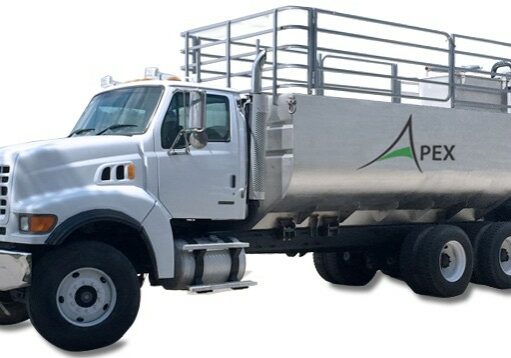Hydroseeding for Wildfire Suppression & Revegetation

Share this article!
Hydroseeding is a planting process that uses a combination of seed, mulch, and fertilizers to promote quick germination and growth. This mixture, known as slurry, gets thoroughly mixed inside a tank before being sprayed in a uniform layer over the prepared ground. The speed and range of this process makes hydroseeding especially effective for both suppressing live fires and promoting revegetation after wildfires.
What is Wildfire Suppression?
Wildfire suppression refers to a range of techniques used by firefighters to combat wildfires. The location of the wildfires, on generally wild or unmaintained land, means terrain is often unpredictable and requires a variety of techniques to meet the unique challenges of every different type of environment.
Wildfire suppression includes both the activities taken to extinguish a live fire, as well as the tactics used to contain and prevent its spread. Depending on the situation and terrain, a mix of different techniques may be employed in different areas to prevent the spread to populated areas or to reduce material damage.
Why Revegetation after a Wildfire Matters
After a wildfire, land can be susceptible to a range of issues, including erosion, runoff, and weed invasions from the loss of trees and vegetation. Without the proper slope stability, mudslides can also become an issue and potentially create even more damage in burned areas.
Once the soil surface is loose, it’s important to begin the revegetation process as soon as possible to protect the ground, stabilize it as much as possible, and encourage new growth. Hydroseeding is an effective method for revegetating after wildfires because it supports each of these initiatives. The slurry that is applied over the ground includes the seeds, nutrients, and fertilizer needed to restore the health of the soil and promote growth. These seeds will be moist and protected as they evenly germinate and prepare the damaged ground and environment for use.
Hydroseeding as a Wildfire Suppression Technique
If wildfires are still active, hydroseeding can help treat the areas where the fires are, and where they are likely to spread. In these areas, a hydroseeder can deliver fire retardant substances and gels in the path of a fire to slow or stop the spread. These substances can even be sprayed directly onto the fire to help contain it.
Hydroseeders Easily Mix and Apply Fire Suppression Chemicals
Because hydroseeders are already designed to uniformly mix and spread mulches and slurries, they can be easily adapted to mix and apply many fire retardant chemicals. Fire suppressing gels and chemicals can be mixed in hydroseeding tanks and delivered over large areas very quickly. The large tanks on rugged hydroseeders can transport fire retardant to hard-to-reach locations, and help provide spray coverage to contain active fires.
Promote New Plant Growth After a Wildfire
Restoring burned areas after a wildfire is especially important to ensure the land remains stable and can withstand fire side effects like erosion, landslides, and flooding. Promoting new growth in burned areas can help stabilize the soil through the root systems of plants and other vegetation. This process helps keep soil in place, reducing runoff and erosion.
Hydroseeders speed up the process of revegetation after a wildfire because they can quickly apply seed and even small shrubs, depending on the machinery, to help establish a root system that will be effective at stabilizing soil in burned areas.
Benefits of Hydroseeding for Fire Suppression
Traditional methods of sowing dry seeds or laying sod can be time-consuming and expensive. Hydroseeding for revegetation after a wildfire is an alternative method that provides a variety of benefits, including:
Speed
Fire retardant products can be mixed and sprayed from a hydroseeder over both burned ground and active fires to help revegetation and prevent the spread of wildfire as quickly as possible.
Extensive Seed Selection
Hydroseeders can work with all kinds of plant seeds from grass to groundcovers and wildflower seeds, providing a variety of options for revegetation after wildfires.
Uniform Germination
Hydroseeders create a homogenous slurry and use a uniform spraying system that creates a consistent layer of seed that will germinate evenly with very little effort.
Control Erosion
Unlike using hay or erosion control blankets, which can blow away while the seeds are germinating or shift in the terrain, hydroseeding slurry features tackifiers to help keep it in place while seeds germinate to better control erosion.
Apply Nearly Anywhere
Hydroseeders are rugged, durable machines designed to navigate all kinds of terrain in all kinds of conditions. Couple that with spray distances of up to 368 ft, and you have a perfect solution for steeply-sloped areas, hard to reach ravines, and more difficult to navigate land that can be prime real estate for wildfires.
Reduced Labor Costs
Hydroseeding typically involves lower material costs compared to traditional seeding or sodding methods. Because the equipment is low-maintenance and designed to be long-lasting, it’s a smart investment. Hydroseeding also generally requires fewer people to apply, when you consider the teams of people it takes to lay sod, or hand plant seeds — the same results can be achieved by a team of two people in a few hours.
Takeaway
Using hydroseeding as a wildfire suppression technique is an effective and efficient solution to apply fire suppression chemicals and to support revegetation after a fire occurs. With easy-to-use design, durable construction, and quick results, hydroseeders can not only help stop a fire in its tracks, it can be used to support the renewal of the land in the aftermath.
For more information about hydroseeding and fire management, contact our team of professionals today to see which equipment may be right for you.
